The 1880s pier at Queenscliff has a vintage shelter half way along, built with seating for waiting ferry passengers, and the old Queenscliff lifeboat shed with steep ramp to launch the boat in a storm
My experience on the pier
Queenscliff Pier is a bit different from any other pier I’ve been to along the Victorian coastline. How many other piers have an old lifeboat shed on the end of them, or a vintage covered seating area half way along, from the days when most people round here got the ferry from place to place?

We were here on a blustery March morning. It was a public holiday in Victoria, so probably busier than on most Monday mornings. But that meant there were all sorts here: a good handful of people fishing, mostly off the far end of the pier, but some on the land side of the seating area too; couples out for a stroll; small clusters of school kids; and families out for a blow and a look at all the activity going on around here.

It is a busy little place, Queenscliff.
From the pier, we could see the big Sorrento ferry a few hundred metres away as it turned away from the harbour to cross the entrance to Port Philip Bay and head over to the Mornington Peninsula.
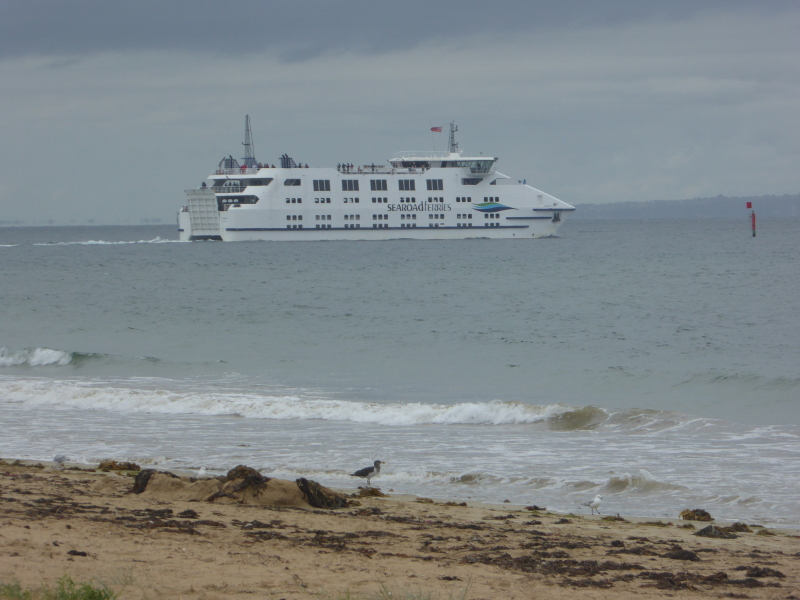
There were big container ships out to sea; smaller vessels closer at hand; and even one little dinghy getting tied up at the pier as we walked along, so this is still a working pier, even if not on the scale it once was.

The best thing about Queenscliff Pier, though, is the covered seating area about half way along. It must be 100m long, painted a nice vintage maroon and khaki, with benches all along both sides, and windows just above head height all the way along the walls. There’s no glass in them now so the breeze blows through, but what a nice spot to sit and have a snack while watching the waves under your feet (through the boardwalk) and out beyond the shelter.
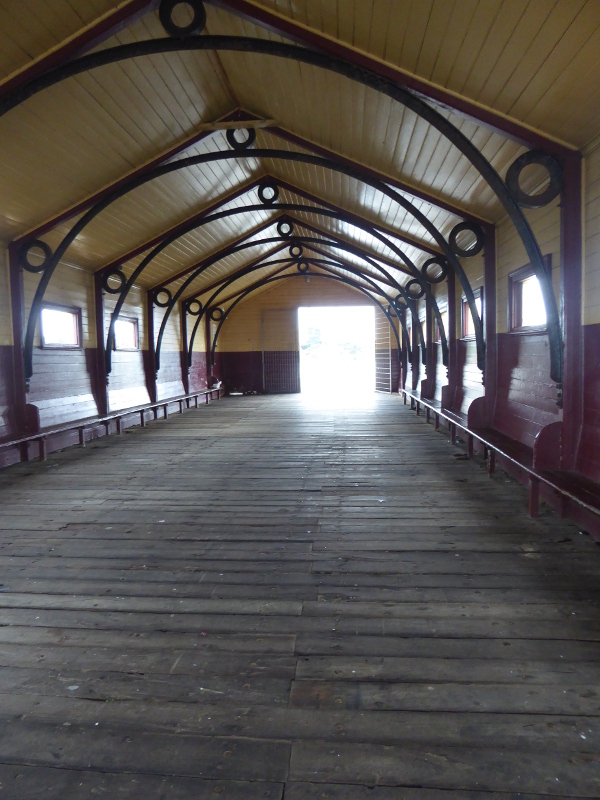
I reckon the pier must be about 300m long in all. It begins in some sand-coloured concrete, though an information sign explains why.

It seems the salt and sand meant the wood was rotting faster at this section of the pier boardwalk, so although they kept the wooden piles which form the base of the pier here, they decided to replace the first 100m or so with this concrete designed to blend in with the surrounding beach.
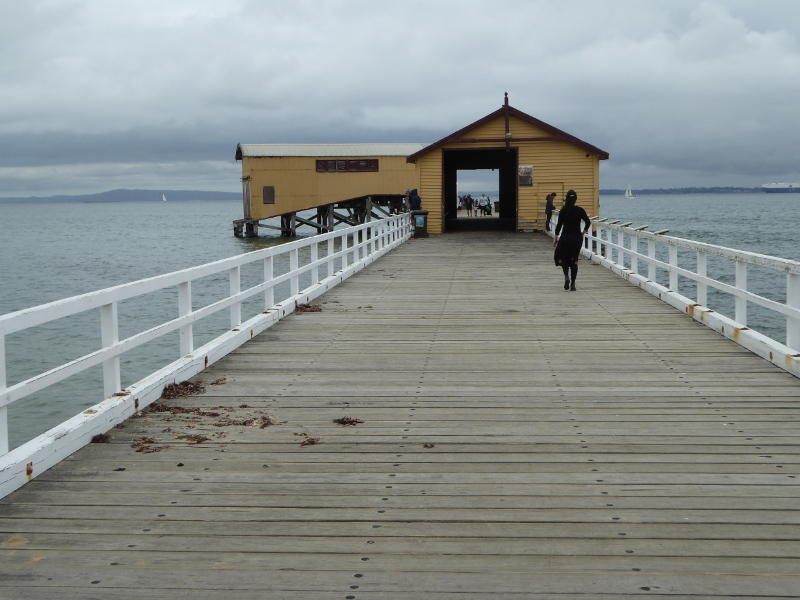
Then the boardwalk begins for the next 100m or so. It was low tide when we walked here, but the lines of seaweed on the beach show that most of the sand gets covered at high tide, and the clumps of seaweed on the pier itself show that the waves splash up here fairly regularly too.
The seated area is a real treat (though it could do with a tiny bit of TLC, we thought – the signs urging people to use the toilets back on the reserve on land suggest that some folk don’t…, and the graffiti must be hard to manage, but does make it look a bit shabby in places). I wondered if the big gates at the start of the covered area meant that in bad weather (or at night?) the pier is closed beyond this point – can anyone confirm?
There’s a lot going on at the end of the pier, though.
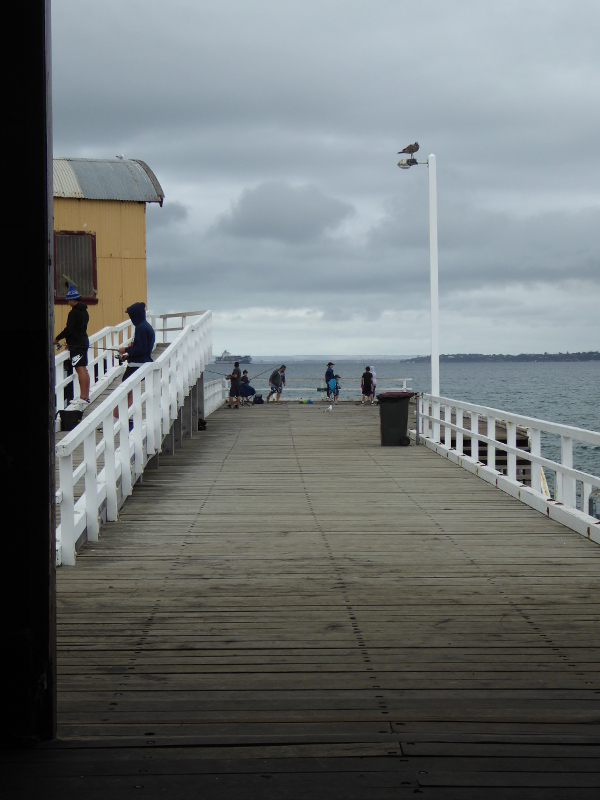
Here is where the serious fishing goes on, for a start. Also that dinghy mooring up as we arrived.
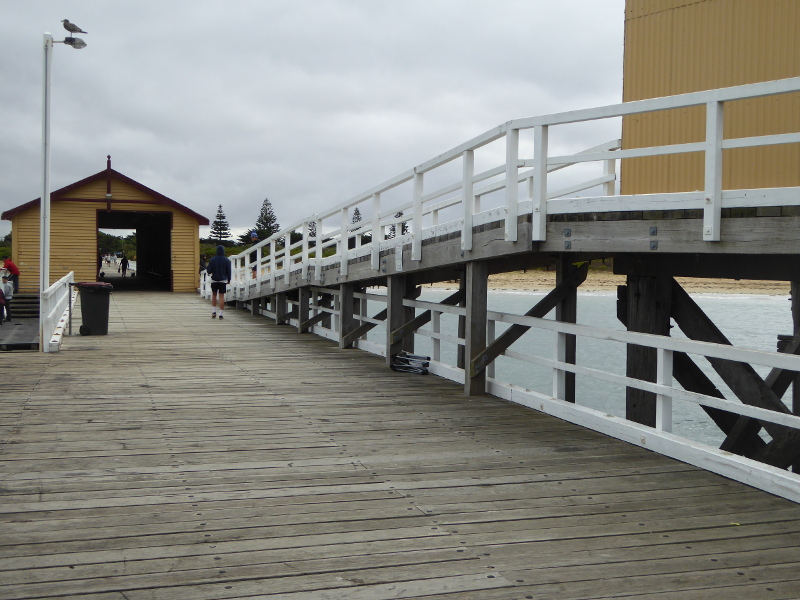
But then there is the narrow sloping pathway up towards the old boat shed, which dominates the end of Queenscliff Pier, and must have been a real focal point for the pier in its 30 years of activity (I learnt from the information boards on the pier).
There must be so many stories to tell about that part of the pier, I wish they allowed public access to the building, with more displays and story-telling about some of the adventures and brave deeds when the life boat operated out of here. As it is, unless you read those info boards at the start of the pier, you might just think this was a disused ferry waiting area as well.
Having done a bit of Trove research before we visited, and found the story of the garrison soldier up on a paternity case in 1902, I did note that there is now a fence at the very end of Queenscliff Pier so there will be no repeat of THAT incident in the 21st century, it seems…
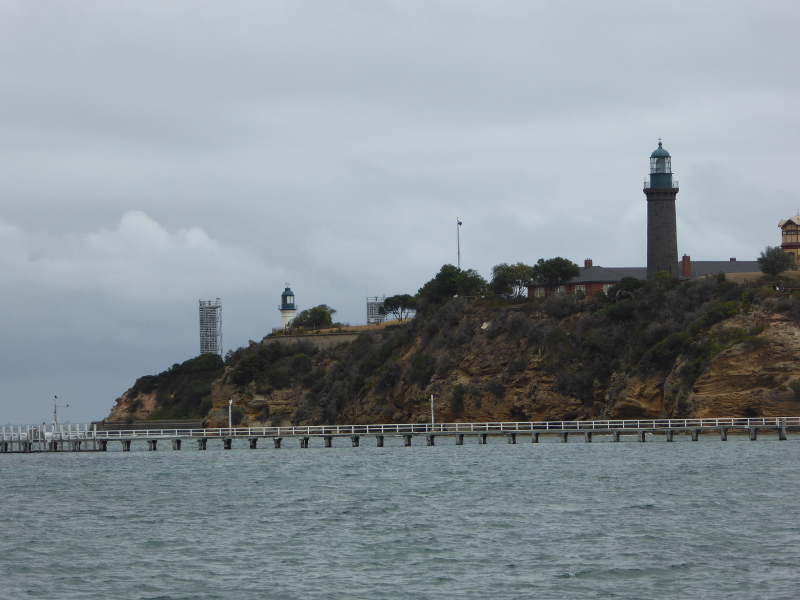
And finally, don’t miss out on spotting the two lighthouses in Queenscliff from the end of the pier. We’ll be back to review those soon, but it was good to see the Black Lighthouse high up inside the fort, and to spot the white one also, lower down and behind the headland.
Practicalities
Nearest toilets are back on the reserve not too far from the pier.
This is one pier where you really can get shelter, with lots of seating! But there are also benches both at the beginning and the end of the pier.
There is even a rubbish bin towards the end of the pier.
History and stories about Queenscliff Pier
The reason this pier sometimes appears as the Queenscliff South Pier is because the original pier in Queenscliff, built in 1860 when the gold rush was making things busy round here, was just to the north of here.
The current Queenscliff Pier was built later, in the 1880s (I’ve seen dates of 1884, 1886 and 1889 so I’m not totally sure of its opening date) to cater for increased ferry traffic into Queenscliff.
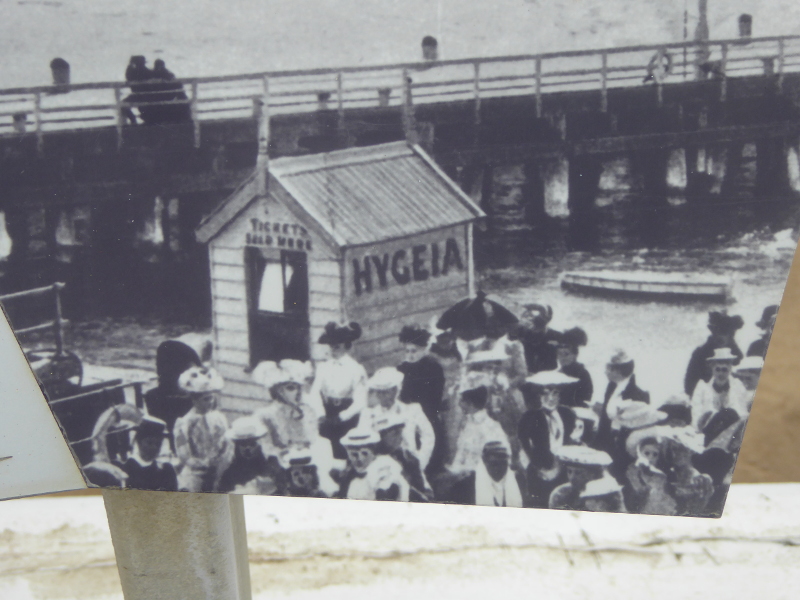
I loved the photo at the start of the pier today which shows the sea baths at Queenscliff, built in 1871. I wonder when they disappeared and what a shame they did.
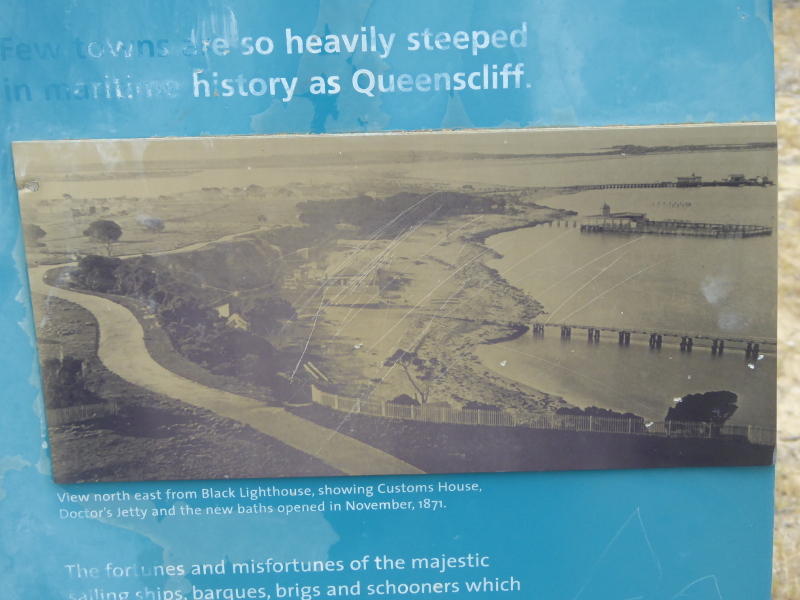
And where were the pier tea rooms, also referred to in those photos? On the pier or nearby? And when did they also close?
So to the ‘new’ pier, built in the 1880s…Trove gave me some lovely stories about this one:-
In 1896 a James Cunningham dived in to save a woman called Miss Bentwitch, who had fallen into the water off the pier. He played down his ‘gallantry’, saying it was always a pleasure to rescue a lady in distress. But I would have loved to hear his punchline which explained that ‘he preferred his bath in the early morning and not in the middle of the day”.
It was not always men who were the heroes. Janet Patterson got a Humane Society award in 1901 for jumping into the water to save her 12 year old friend. She had to remove her hat first, of course, and ended up dragging her unconscious friend back to safety pulling on her long hair to effect the rescue.
The Queenscliff Pier stories were not all about heroism and bravery, though. Sometimes, it was more passion and lust.
A paternity case came to court in 1902, when a member of the garrison at Queenscliff was accused of being the father of a child of a young woman, who argued that they had had intimate relations at the end of Queenscliff Pier. In court she claimed to have been frightened because they were near the edge and there were no railings…
Queenscliff Pier could also be a dangerous place, at times. In 1930, one Friday afternoon in December, two people slipped on the decking of the pier and both broke a leg, in quite separate incidents. Just a week later, a 10 year old girl fell on Queenscliff Pier and broke her jaw! I guess all this may be as much to do with bone health and diet at the time (depression era poverty?) as health and safety issues on the pier. But thank god it hasn’t happened in 2018-9, or they’d be barring access to the whole pier in today’s risk-averse climate…
Queenscliff Pier was often crowded with holidaymakers taking the ferries across the bay, and there were frequent complaints in the newspapers about the crowds not being better organised. But a ceremony of ‘blessing’ in 1936 produced perhaps the largest congregation ever to stand on and around the pier. This was the time the Bishop of Riverina blessed the fishing fleet. It was apparently the second time a fishing fleet had been blessed in Australia. “Trumpeters sounded a fanfare and then the fleet received a special benediction,” Sydney’s Daily Telegraph reported. All this in front of 7,000 onlookers. There were further similar events in 1939 and 1949. I wonder when they stopped?
A new section to the pier in the 1950s was soon vandalised, when power lines were torn down, endangering operation of the lifeboat. And times were tough for the lifeboat itself in the mid-50s. Some volunteer crew members quit the service in protest at the lack of replacement for the leaking vessel they were launching down the ramp at Queenscliff Pier.
This was a far cry from the earlier days of the Queenscliff lifeboat. I loved the dramatic descriptions of the wreck bell being sounded in the 1940s In the middle of the night, and all the lifeboatmen racing to the pier to put on their oilskins over their pyjamas to save the crew of a wrecked vessel out on the reef. At the time, Queenscliff had Australia’s first purpose-built motorised lifeboat, and it would speed down the pier ramp into the water at 30mph. Crew members reckoned they needed just 15 minutes from the time the bell sounded, whether they were in suits at the pictures or sound asleep at home, to get the boat ready for launch down that ramp.
People linked to this place
The Thwaites family deserve a special mention in connection with the lifeboat service at Queenscliff. Three generations of Thwaites men served 100+ years for the Queenscliff Lifeboat, some of which would have been out of the lifeboat shed that still stands on the pier today.
Tom Thwaites got himself in the news several times, both for his involvement in rescues off Queenscliff, and for his protest at the state of the leaking lifeboat when he and his son quit the service in the mid-1950s.
His grand-daughter wrote this rather nice memorial piece about all of her relatives in Queenscliff in 2013. She describes how heart-stoppingly frightening it was to hear the sound of the shipwreck bell on the only occasion it rang in her lifetime. But I also learnt that Tom Thwaites lived in Station Cottage on Wharf Street, so it would be nice to walk past next time we are in Queenscliff.

And I couldn’t resist another story, though this one is not directly linked to Queenscliff Pier…
Unsolved mysteries are the most intriguing parts of Vintage Victoria and although the one I have chosen here does not directly involve the pier, it did take place in the waters around Queenscliff so the pier may well have been one of the last things this particular character saw…
Captain F H Stanford was a pilot based at Queenscliff who disappeared in 1909 while guiding a ship full of wheat bound for England out through the heads here. His body was never found so what happened to him remained a mystery, which was still being talked about as late as 1945, and I even found a local newspaper article remembering the story in 2013 (Scroll down to page 12 of this Queenscliffe Herald piece)
Other links and writings on Queenscliff Pier
The Heritage Council of Victoria have a nice entry on Queenscliff Pier.
There are some lovely photos of the pier on the Queenscliff Historical Museum website.
I rather liked Peter Fuller’s dive blog because it gives a different perspective on the pier, with photos of what’s underneath those boardwalks…
This YouTube channel has a five minute video of a walk along Queenscliff Pier.
This article from July 2018 discusses funding to help restore parts of the pier.
What are your stories and memories of Queenscliff Pier?
Can you remember the lifeboat launching off the pier at Queenscliff? Was there any incident that stuck with you through the years?
Can anybody remember hearing that shipwreck bell sounding?
Or do you just have good memories of a romantic stroll, a school visit, or maybe a holiday trip that involved a visit to the pier?
Comment below if you have anything to add.
Coffee near or tea on the pier?
We really wish the old Pier Tea Rooms were still around…But in their absence there are a good few coffee shops in Queenscliff village itself. Our favourite was Belsize & Co in Hesse Street. Really good coffee and very friendly atmosphere.


Lots of history in Queenscliff especially at the Queenscliff Historical Museum-great people.